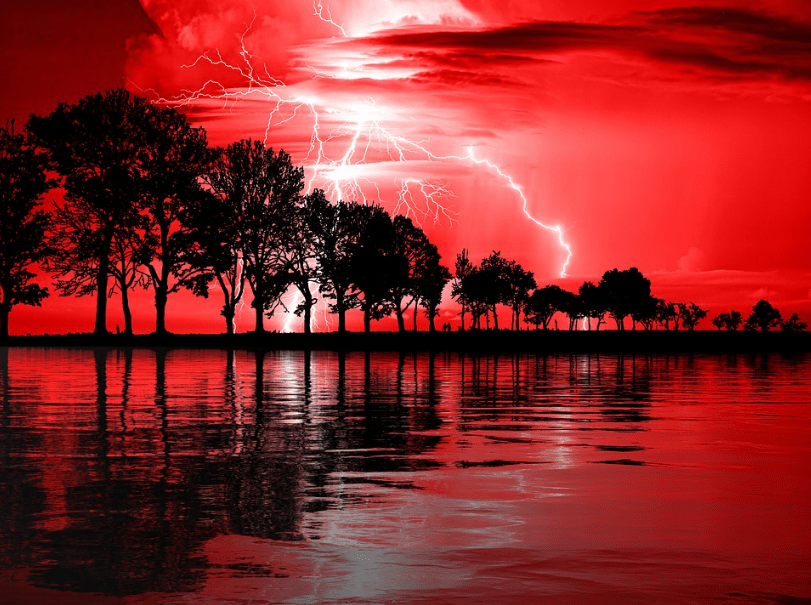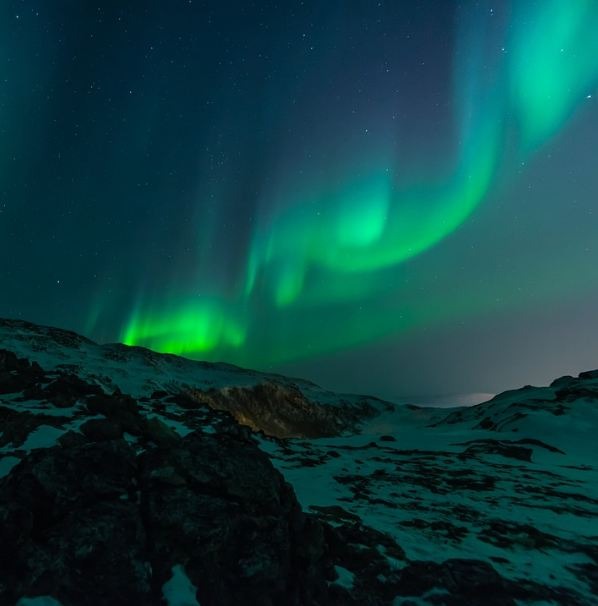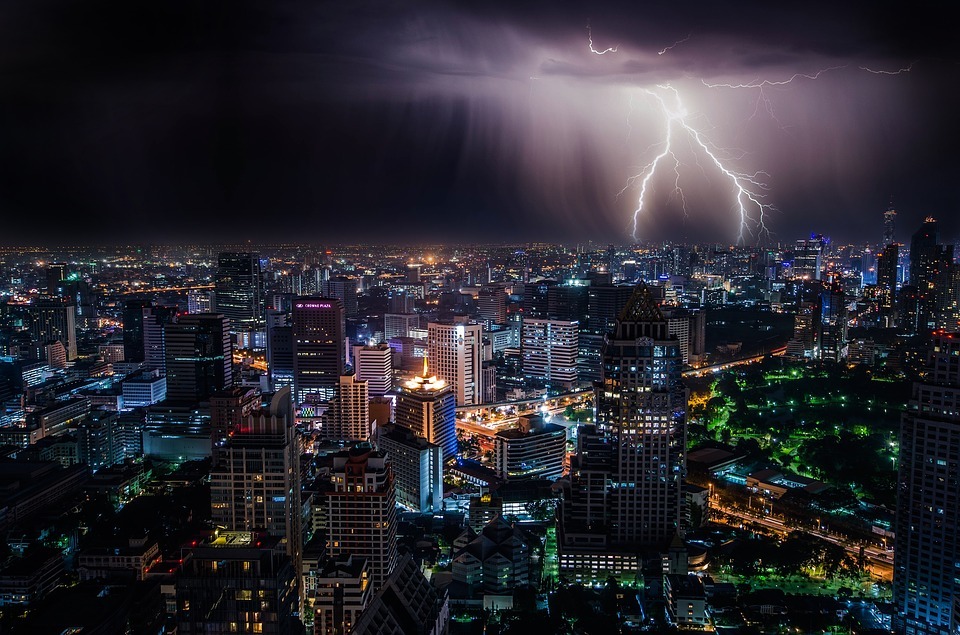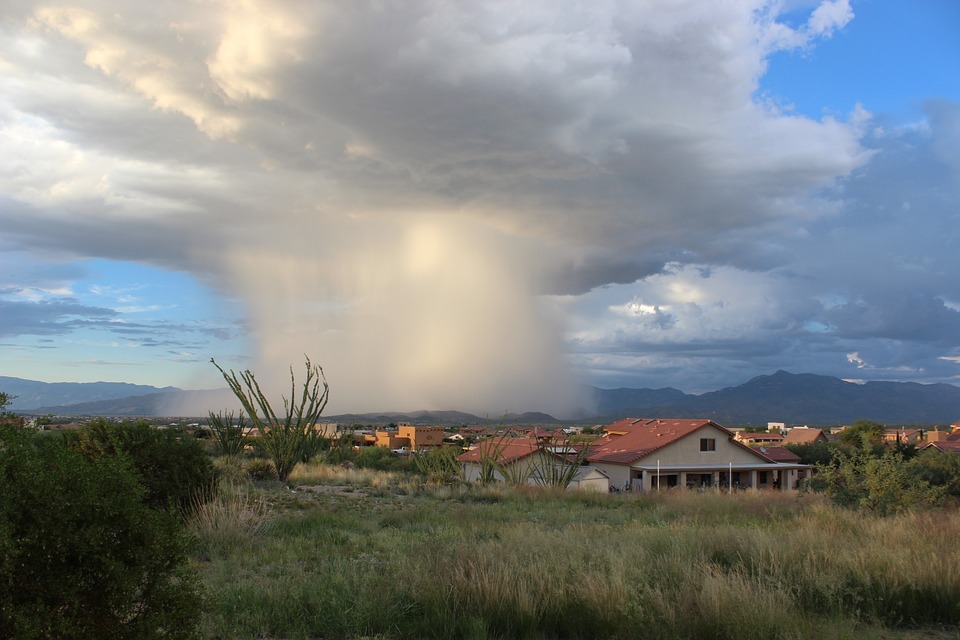What Causes Frost Quakes to Happen?
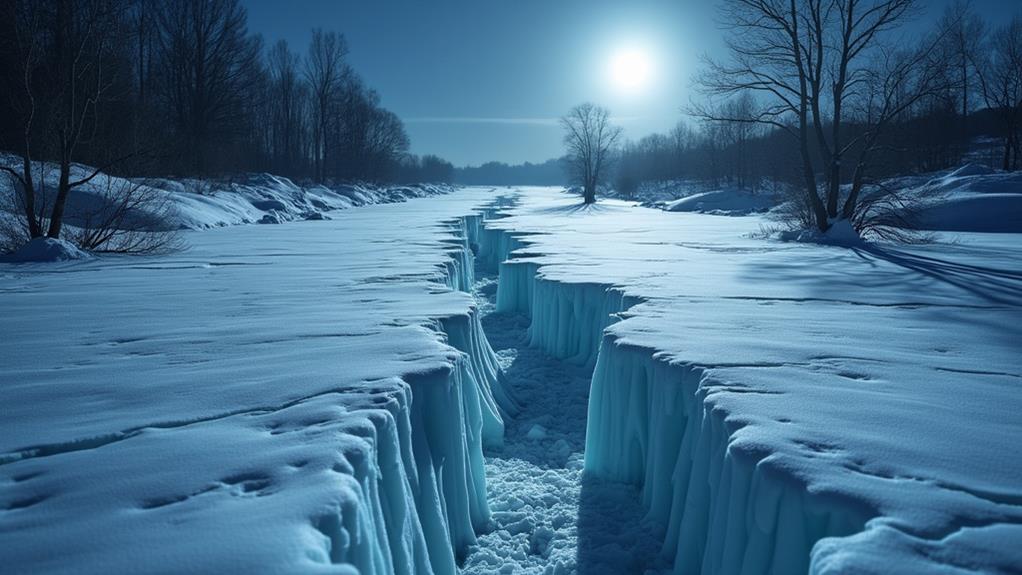
Frost quakes, also known as cryoseisms, occur when rapid temperature drops cause groundwater in saturated soil to freeze and expand rapidly. This expansion creates stress that fractures the ground, producing loud booming sounds and minor ground shaking. Conditions are ideal when the soil is nearly saturated, after wet weather, and temperatures dip below -20°C (-4°F), usually at night. Geological factors, such as soil composition and existing fractures, also play a role. If you want to understand the precise mechanics and where they typically happen, there's more fascinating information to uncover.
Key Takeaways
- Rapid temperature drops below -20°C (-4°F) cause groundwater to freeze and expand, leading to ground fractures.
- High soil moisture levels from precipitation or snowmelt set the stage for freezing and stress in the ground.
- Saturated soil with minimal air pockets allows effective freezing and expansion, crucial for frost quakes.
- Geological factors like soil composition and bedrock type influence ground cracking under freezing conditions.
- Cold, wet periods followed by sudden freezes increase the likelihood of frost quakes, especially at night.
Definition and Characteristics
Frost quakes, also known as cryoseisms, are intriguing seismic events that occur when frozen ground, soil, or rock fractures rapidly due to sudden temperature drops. You might hear a loud booming sound and feel minor ground shaking when a cryoseism happens. These phenomena are often mistaken for minor earthquakes but rarely cause significant damage.
For frost quakes to occur, the soil needs to be nearly saturated with minimal airspace, a condition most likely after wet weather. When the temperature drops rapidly, the moisture in the soil freezes and expands, creating stress that fractures the frozen soil. This sudden fracture produces the seismic event and the accompanying sound, which can be startling.
Frost quakes usually happen at temperatures below -20°C (-4°F) and are more frequently reported during nighttime. The rapid temperature drop at night makes the conditions ideal for these events. The sounds generated during cryoseisms are often compared to snapping branches or popping bubble wrap, adding to the confusion if you're unfamiliar with the phenomenon. Understanding these characteristics helps distinguish frost quakes from other seismic events, ensuring you're aware of their unique nature.
Rapid Temperature Drops
When rapid temperature drops occur, the conditions become perfect for triggering frost quakes. These dramatic declines in temperature, often plummeting below -20°C (-4°F), play an essential role in frost quakes' occurrence. When the temperature drops suddenly, any liquid water within the soil freezes and expands. This expansion creates significant stress within the ground, leading to cracks and the loud booms associated with this cold weather phenomenon known as cryoseism.
Rapid temperature drops are particularly effective following wet periods where the ground has absorbed plenty of water. Minimal snow cover during these times allows the soil to freeze quickly and uniformly, making it more susceptible to cracking. Cold air masses descending unexpectedly can lead to these extreme temperature drops, and regions experiencing such weather patterns are at higher risk for frost quakes.
Typically, the phenomenon is most commonly reported at night. Nighttime temperatures tend to drop more sharply, creating the perfect conditions for cryoseismic activity. So, when you experience a sudden chill and hear mysterious cracking sounds, it's likely a frost quake resulting from a rapid temperature drop and the soil's freezing and expanding process.
Soil Saturation Levels
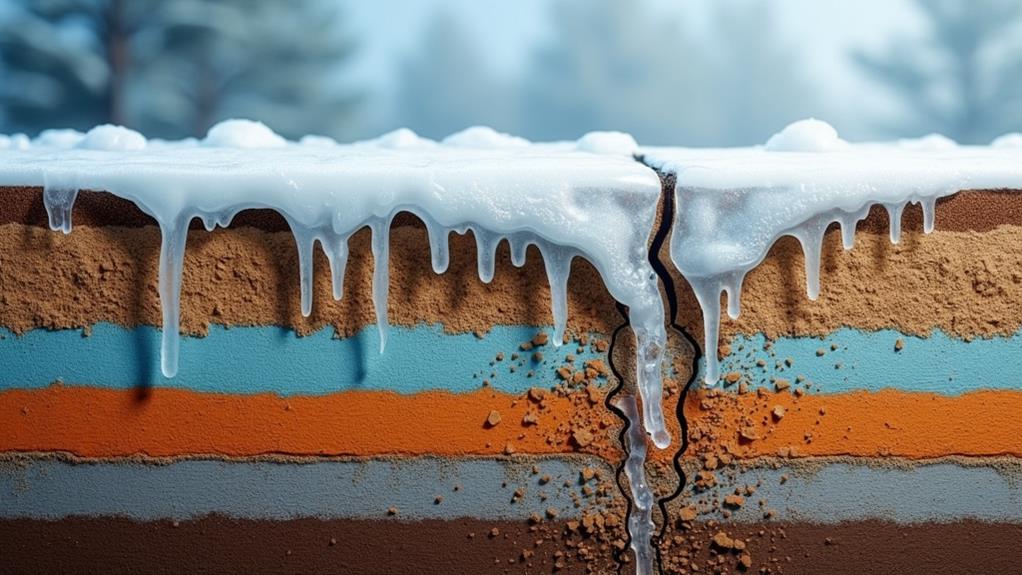
Soil saturation levels play a vital role in the occurrence of frost quakes. When the soil is nearly saturated, it allows freezing water to expand, creating significant pressure that can lead to these seismic events. For frost quakes to happen, specific conditions need to be met in the soil:
- High precipitation levels: Heavy rainfall or rapid snowmelt increases soil moisture, making frost quakes more likely during subsequent freezing conditions.
- Minimal airspace in soil: Soil with little airspace facilitates rapid freezing, which is fundamental for the sudden expansion that causes frost quakes.
- Depth of saturation: The deeper the soil saturation, the more potential there is for cracking and ground movement.
After periods of heavy rain or snowmelt, the ground absorbs more moisture, saturating the soil. When temperatures suddenly drop, the water within this saturated soil begins to freeze. As freezing water expands, it builds up pressure. If this pressure becomes too great, it results in a frost quake. Areas with higher precipitation, especially in fall or winter, are particularly prone to these events due to increased moisture levels. Consequently, monitoring soil saturation can help predict the likelihood of frost quakes, enabling better preparedness for these natural phenomena.
Groundwater and Ice Expansion
Understanding soil saturation levels lays the groundwork for comprehending the mechanics of frost quakes, but groundwater and ice expansion are likewise significant contributors. When groundwater beneath the soil rapidly freezes, it expands by about 9%, exerting substantial pressure on the surrounding soil and rock layers. This sudden expansion isn't just a minor shift; it's a powerful force that can cause the ground to crack and produce loud booming sounds akin to a pipe bursting under freezing conditions.
For frost quakes to occur, the soil needs to be saturated, meaning it's filled with minimal air pockets. Saturated soil guarantees that any moisture present will effectively freeze and expand. If the ground is dry or has too many air gaps, the chances of a frost quake diminish. The critical moment happens when there's moisture in the ground right before a rapid temperature drop. This combination sets the stage for the freezing process to begin.
As the water in the saturated soil freezes, the resulting ice expansion creates enough pressure to fracture the ground, leading to the tremors and sounds characteristic of frost quakes. Understanding these processes helps demystify the sudden, startling phenomena experienced during cold snaps.
Geological Factors
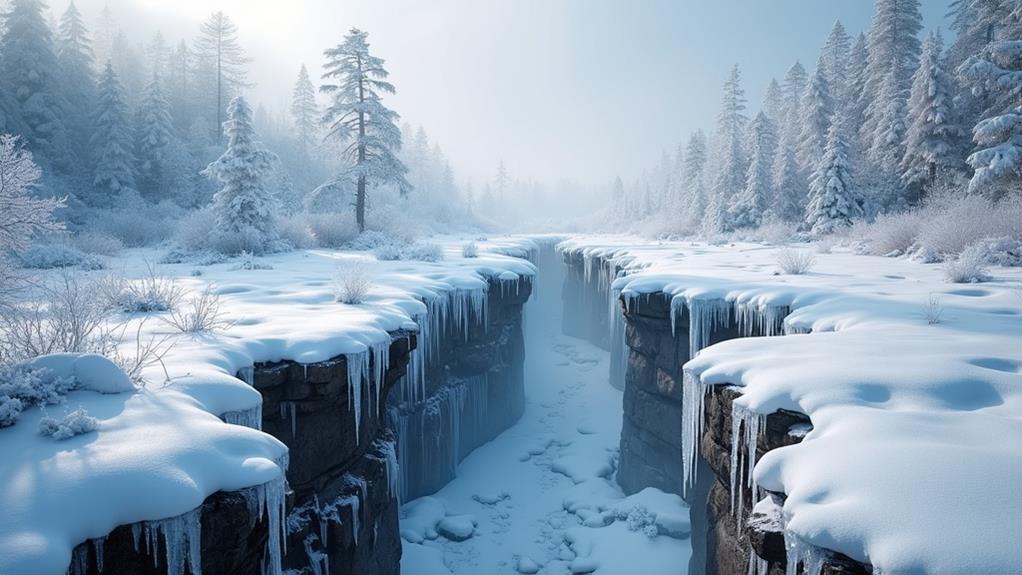
Geological factors play a vital role in the occurrence of frost quakes. When you're dealing with cryoseismic activity, understanding the ground's composition is imperative. The type of soil or rock, its saturation with water, and the underlying geological structures all contribute to the likelihood and intensity of frost quakes.
- Soil Composition: The presence of clay and moisture levels in the soil can markedly influence how easily the ground cracks under stress. Soils that are deeply saturated with water are particularly prone to frost quakes because they freeze and expand rapidly when temperatures drop.
- Geological Structures: Fractures or faults in the ground act as weak points, making them more susceptible to the rapid stress release that characterizes frost quakes. These structures can serve as natural pathways for the energy release, leading to more frequent cryoseismic activity.
- Type of Bedrock: Different rock types react differently under freezing conditions. Some bedrocks may fracture more readily, facilitating the occurrence of frost quakes.
Common Locations
Frost quakes, also known as cryoseisms, often make their presence known in regions experiencing extreme cold. If you're in areas like Alaska, Canada, or parts of Scandinavia, you're likely to encounter this phenomenon. The northeastern United States, including states such as Connecticut, Massachusetts, Maine, and Vermont, is particularly susceptible to frost quakes. These regions' cold climates make them prime candidates for cryoseismic activity.
Canada has a notable history with frost quakes. Significant seismic activity has been reported in Ontario, Quebec, Alberta, and the Maritime Provinces. For instance, historical records show occurrences in New Brunswick from 1817 to 1961, highlighting a long-standing presence. The Great Lakes and St. Lawrence corridor stands out as a significant hotspot due to unique climatic and geological conditions.
In the United States, you might hear about frost quakes in Michigan, Wisconsin, Ohio, Indiana, Missouri, and even Tennessee. These areas' cold winters make them prone to the sudden freezing and expansion of water in the ground, leading to the seismic activity characteristic of frost quakes. Understanding where frost quakes occur helps you prepare for and recognize this fascinating natural phenomenon.
Effects on Environment
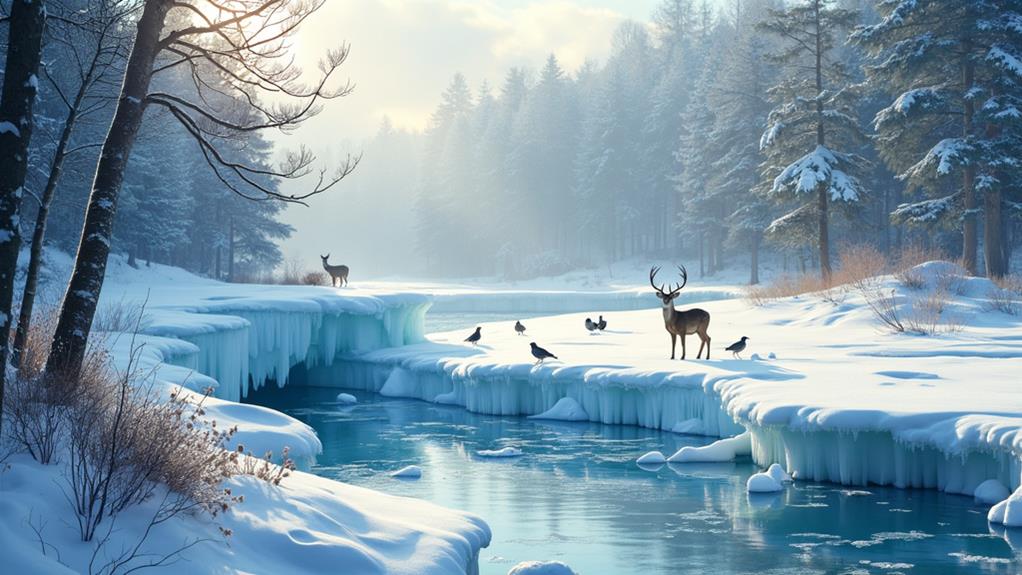
When frost quakes strike, they can greatly disrupt local ecosystems. These ground disturbances often affect plant root systems and soil structure, causing significant environmental impacts. The sudden release of stress in the frozen ground creates surface cracks that alter drainage patterns, impacting water availability for vegetation and other flora. This makes it harder for plants to thrive and can lead to changes in the landscape.
Wildlife habitats don't escape unscathed either. The noise and vibrations from frost quakes can disturb animal behavior and migration patterns, making it difficult for wildlife to maintain their usual routines. Animals may abandon their habitats or change their migration routes, which could have cascading effects on the ecosystem.
Moreover, frost quakes can lead to localized changes in soil temperature. These temperature shifts can affect microbial activity and nutrient cycling within the environment, potentially disrupting the delicate balance necessary for healthy soil.
Here are a few key impacts to reflect on:
- Plant root systems and soil structure: Ground disturbances can damage roots and alter soil composition.
- Water drainage patterns: Surface cracks can change how water moves through an area, affecting plant hydration.
- Wildlife behavior: Noise and vibrations can lead to changes in animal behavior and habitat use.
Understanding these effects can help you appreciate the broader environmental implications of frost quakes.
Research and Studies
Understanding the environmental impacts of frost quakes naturally leads us to investigate the scientific research behind these phenomena. Research indicates that frost quakes occur due to rapid temperature drops, causing groundwater to freeze swiftly. This rapid freezing creates stress in the soil and rock layers, leading to cracking.
A significant 2016 study highlighted a potential increase in frost quake frequency linked to climate change. Warmer winters result in longer periods of thawed ground and higher moisture levels in the soil, making conditions ripe for frost quakes. Finnish researchers in regions like Oulu and Sodankylä have installed seismic instruments to monitor these events. They've detected numerous frost quakes, revealing unique waveforms in the seismic data that help differentiate them from other seismic events.
Ongoing studies are focusing on the relationship between climate trends and frost quake frequency. Predictions suggest that wetter winters and decreasing snow cover may heighten ground susceptibility to these phenomena. Historical records from places like Ontario, Canada, and several U.S. states provide valuable data, showing notable clusters of frost quakes. These findings are prompting further research into their patterns and underlying causes, enhancing our understanding of this fascinating natural occurrence.
Frequently Asked Questions
How Do Frost Quakes Occur?
Frost quakes occur when temperature fluctuations cause soil moisture to freeze rapidly. As the water in the ground expands during these freeze-thaw cycles, it builds up pressure. This pressure creates seismic activity, leading to cracking and ground expansion. You'll often hear loud booms and feel minor tremors, especially when temperatures drop below -20°C (-4°F) at night. Geological factors like soil composition and moisture levels play an essential role too.
Do Frost Quakes Cause Damage?
When frost quakes knock on your door, their effects can be more of a nuisance than a disaster. These events might exploit structural vulnerabilities, causing minor issues like cracks from ground movement. Insulation failure can become apparent, leading to unexpected repairs. While the loud booms are startling, actual damage is minimal, rarely severe enough to affect property insurance. Typically, frost quakes just add a bit of extra wear and tear.
What Causes Frost Spikes?
Frost spike formation occurs when temperature fluctuations cause soil moisture to freeze rapidly. In winter weather, when temperatures suddenly drop, the water in nearly saturated soil turns into ice. This ice expansion creates pressure, leading to fractures in the surrounding soil or rock. Frost spikes are more likely during periods of extreme cold following wet conditions, as the rapid freeze-thaw cycle intensifies the ice expansion process.
What Causes a Frost Warning?
Imagine waking up to a glistening, icy landscape. A frost warning happens when cold temperatures, clear skies, and calm weather patterns combine, leading to rapid frost formation. The NWS issues these warnings, alerting you to take winter precautions. Soil moisture and cold temperatures play key roles, turning dew into frost. Protecting plants and staying aware of potential road hazards are essential actions when a frost warning is in effect.

